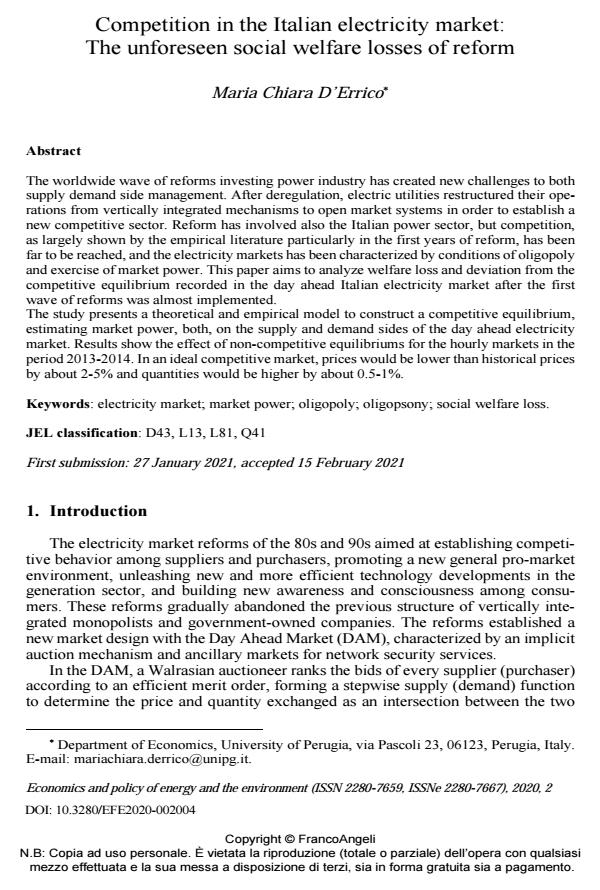Competition in the Italian electricity market: The unforeseen social welfare losses of reform
Titolo Rivista ECONOMICS AND POLICY OF ENERGY AND THE ENVIRONMENT
Autori/Curatori Maria Chiara D’Errico
Anno di pubblicazione 2021 Fascicolo 2020/2 Lingua Inglese
Numero pagine 17 P. 75-91 Dimensione file 226 KB
DOI 10.3280/EFE2020-002004
Il DOI è il codice a barre della proprietà intellettuale: per saperne di più
clicca qui
Qui sotto puoi vedere in anteprima la prima pagina di questo articolo.
Se questo articolo ti interessa, lo puoi acquistare (e scaricare in formato pdf) seguendo le facili indicazioni per acquistare il download credit. Acquista Download Credits per scaricare questo Articolo in formato PDF

FrancoAngeli è membro della Publishers International Linking Association, Inc (PILA)associazione indipendente e non profit per facilitare (attraverso i servizi tecnologici implementati da CrossRef.org) l’accesso degli studiosi ai contenuti digitali nelle pubblicazioni professionali e scientifiche
The worldwide wave of reforms investing power industry has created new challenges to both supply demand side management. After deregulation, electric utilities restructured their opera-tions from vertically integrated mechanisms to open market systems in order to establish a new competitive sector. Reform has involved also the Italian power sector, but competition, as lar-gely shown by the empirical literature particularly in the first years of reform, has been far to be reached, and the electricity markets has been characterized by conditions of oligopoly and exercise of market power. This paper aims to analyze welfare loss and deviation from the competitive equilibrium recorded in the day ahead Italian electricity market after the first wave of reforms was almost implemented. The study presents a theoretical and empirical model to construct a competitive equilibrium, estimating market power, both, on the supply and demand sides of the day ahead electricity market. Results show the effect of non-competitive equilibriums for the hourly markets in the period 2013-2014. In an ideal competitive market, prices would be lower than historical prices by about 2-5% and quantities would be higher by about 0.5-1%.
Keywords:Electricity market; market power; oligopoly; oligopsony; social welfare loss
Jel codes:D43, L13, L81, Q41
- Anielski M., Bushnell J., Wolak F.A. (2002). Measuring market inefficiencies in California’s restructured wholesale electricity market. The American Economic Review, 92(5): 1376-1405. DOI: 10.1257/000282802762024557
- Athey S., Haile P.A. (2006). Empirical models of auctions. Working Paper, 12126, National Bureau of Economic Research, 2006.
- Bigerna S., Bollino C.A. (2014). Measuring oligopsony market power in the Italian electricity market: preliminary results. International Advances in Economic Research, 20(4), 457-459.
- Bigerna S., Bollino C.A. (2016). Demand market power and renewables in the Italian electricity market. Renewable and Sustainable Energy Reviews, 5: 1154-1162.
- Bigerna S., Bollino C.A., Polinori P. (2016). Market power and transmission congestion in the Italian electricity market. The Energy Journal, 37(2): 133-154.
- Boffa F., Pingali V., Vannoni D. (2010). Increasing market interconnection: an analysis of the Italian electricity spot market. International Journal of Industrial Organization, 28(3): 311-322.
- Bolle F. (1992). Supply function equilibria and the danger of tacit collusion: the case of spot markets for electricity. Energy Economics, 14(2): 94-102.
- Bolle F. (2001). Competition with supply and demand functions. Energy Economics, 23: 253-277. DOI: 10.1016/S0140-9883(00)00061-X
- Borenstein S., Bushnell J.B., Wolak F.A. (2000). Diagnosing market power in California’s restructured wholesale electricity market. Working Paper, 7868, National Bureau of Economic Research.
- Borenstein S., Bushnell J.B., Wolak F.A. (2002). Measuring market inefficiencies in California’s restructured wholesale electricity market. The American Economic Review, 92(5):1376-1405. DOI: 10.1257/000282802762024557
- Bosco B., Parisio L., Pelagatti M. (2012). Strategic bidding in vertically integrated power markets with an application to the Italian electricity auctions. Energy Economics, 34: 2046-2057.
- Cramton P. (2004). Competitive bidding behavior in uniform-price auction markets. System Sciences, 2004. Proceedings of the 37th Annual Hawaii International Conference: 1-11, IEEE. DOI: 10.1109/HICSS.2004.1265172.
- Green R.J., Newbery D.M. (1992). Competition in the British electricity spot market. Journal of Political Economy, 100(5): 929-953. DOI: 10.1086/261846
- Guerre E., Perrigne I., Vuong Q. (2000). Optimal nonparametric estimation of first-price auctions. Econometrica, 68(3): 525-574. DOI: 10.1111/1468-0262.00123
- Harvey S., Hogan W. (2002). Market power and market simulations. Technical report, Center for Business and Government John F. Kennedy School of Government; Harvard University.
- Holmberg P., Newbery D., Ralph D. (2013). Supply function equilibria: step functions and continuous representations. Journal of Economic Theory, 148(4): 1509-1551.
- Hortacsu A., Puller S.L. (2008). Understanding strategic bidding in multi-unit auctions: a case study of the Texas electricity spot market. The RAND Journal of Economics, 39(1): 86-114.
- Joskow P., Kohn E. (2002). A quantitative analysis of pricing behavior in California’s wholesale electricity market during summer 2000. The Energy Journal, 23(4): 1-35.
- Mansur E.T. (2008). Measuring welfare in restructured electricity markets. The Review of Economics and Statistics, 90(2): 369-386.
- Newbery D.M. (1998). Competition, contracts, and entry in the electricity spot market. The RAND Journal of Economics, 29(4): 726-749. DOI: 10.2307/2556091
- Parisio L., Bosco B. (2003). Market power and the power market: multi-unit bidding and (in) efficiency in electricity auctions. International Tax and Public Finance, 10(4): 377-401. DOI: 10.1023/A:1024602609265
- Reguant M. (2014). Complementary bidding mechanisms and startup costs in electricity markets. The Review of Economic Studies, 81(4): 1708-1742.
- Sapio A., Spagnolo N. (2016). Price regimes in an energy island: tacit collusion vs. cost and network explanations. Energy Economics, 55: 157-172.
- Wolak F.A. (2000). An empirical analysis of the impact of hedge contracts on bidding behavior in a competitive electricity market. International Economic Journal, 14(2): 1-39. DOI: 10.1080/10168730000080009
- Wolak F.A. (2003). Measuring unilateral market power in wholesale electricity markets: the California market, 1998-2000. The American Economic Review, 93(2): 425-430. DOI: 10.1257/000282803321947461
- Wolfram C.D. (1999). Measuring duopoly power in the British electricity spot market. The American Economic Review, 89(4): 805-826.
Maria Chiara D’Errico, Competition in the Italian electricity market: The unforeseen social welfare losses of reform in "ECONOMICS AND POLICY OF ENERGY AND THE ENVIRONMENT" 2/2020, pp 75-91, DOI: 10.3280/EFE2020-002004